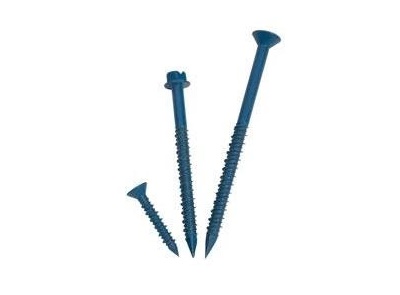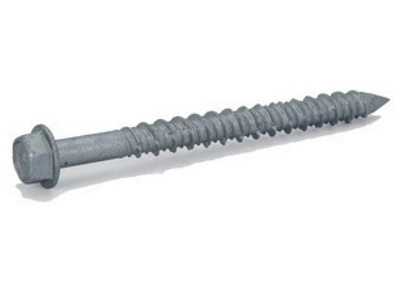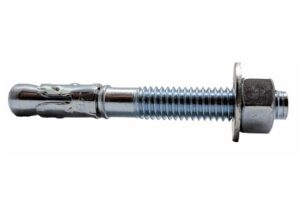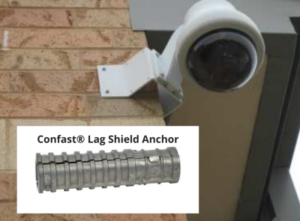 All home improvement and construction projects have different requirements. It is important to use the correct concrete screw to ensure that the installation is performed correctly and safely. Concrete screws are specifically designed to tap their own threads into pre-drilled holes. They can be used in a variety of base materials including concrete, brick, and block. These screws are known for their ease of installation, superior pull-out resistance, and strong holding values.
All home improvement and construction projects have different requirements. It is important to use the correct concrete screw to ensure that the installation is performed correctly and safely. Concrete screws are specifically designed to tap their own threads into pre-drilled holes. They can be used in a variety of base materials including concrete, brick, and block. These screws are known for their ease of installation, superior pull-out resistance, and strong holding values.
Applications for Concrete Screws
Concrete screws are very versatile and are ideal for use in both light and medium duty fastening applications. These screws come in a variety of sizes and styles that are easily installed. After installation, concrete screws can be removed without disturbing the base material. These screws are useful because they can be installed close to edges, unlike other types of fasteners. The different lengths can be used when the fastening material has a thickness of up to 5″. This wide range of lengths allows the screws to be used to fasten studs, plywood, electrical boxes, exterior insulation systems and many other applications.
 Concrete Screw Threads
Concrete Screw Threads
The industry term for the threads of concrete screws is “High-Low”. The design of “High-Low” threads assists with dust removal during installation. This type of thread also permits the screw to tap threads consistently and delivers high-quality performance. When the threads are cut into the base material it is important that the dust must be removed as quickly as it is created. This ensures smooth and consistent installation, with less torque required to insert the screw into the base material.
If the dust is removed slower than it is created, several problems can occur. The screw can bind up in the hole, preventing further insertion and/or prohibiting the removal of the screw. Also, if the screw binds in the hole and too much torque is applied, the head of the screw can shear off. Since the lead thread is doing all the cutting of the base material, the quality of the steel and thread forming is extremely important when using these screws.
Hole Requirements
As with all concrete anchors, the hole tolerance for a concrete screw is critical. Always use a hammer drill and a matched tolerance carbide tipped masonry bit when installing concrete screws.
Tech Tip:
- 1/4″ diameter screws use a 3/16″ bit
- 3/16″ diameter screws use a 5/32″ bit
The hole should always be drilled at least 1/4″ deeper than the required embedment. This will guarantee that the screw does not bottom out before it reaches the desired depth of embedment. If the screw bottoms out because the hole is not deep enough; it will stop, bind up and most likely shear off at the head.
Masonry bits come in different lengths to accommodate the different lengths of screws that are available. These bits are typically available in 3-1/2″, 4-1/2″, and 5-1/2″ lengths.
Embedment Requirements
Concrete screws require a minimum embedment of no less than 1″ and a maximum embedment of 1-3/4″ into the base material. An embedment of less than 1″ should not be used because this will diminish the holding values of the screw.
True holding values are not known in this situation.
Trying to embed the screw deeper than 1-3/4″ could cause a variety of problems, including:
- The screw binding in the hole, prohibiting it from going any further
- Prohibiting the removal of the screw
- Shearing off the screw head
It is also important to note that the harder the base material, the less the maximum embedment should be. The lead thread may lose its ability to cut into the base material after 1-3/4″, especially if the base material is extra hard or abrasive.
Determining the Length of Concrete Screw to Use
Each application may require a different concrete screw length. To determine the length of screw required, follow the instructions below:
- Thickness of the material to be fastened + (a minimum of 1″ or a maximum of 1-3/4″) = the required length of screw
Keep in mind that all concrete screws are measured from under the head. For example, when fastening a 2×4 to concrete, the 2×4 is 1-1/2″ thick. Take 1-1/2″ plus a minimum of 1″ and a maximum of 1-3/4″ embedment. This provides a total of 2-1/2″ to 3-1/4″ for the screw length. Concrete screws are available in lengths of 2-3/4″ and 3-1/4″. In this case, the 2-3/4″ screw would be the proper choice, as the embedment would be 1-1/4″.
Installation of Concrete Screws
The installation of a concrete screw is quite simple. Installation can be completed in three steps:
- Using a hammer drill and a correctly sized carbide tipped masonry bit, drill a pilot hole 1/4″ deeper than the recommended embedment.
- Clear the hole of all debris.
- Using a standard drill with the appropriate hex or Phillips socket, drive the concrete screw into the pre-drilled hole until the screw is fully seated.
** Be careful not to over-tighten the screw, this may cause the screw to spin in the hole stripping the threads.
For more detailed step-by-step installation information, please view this Concrete Screw Installation Video: CONFAST YouTube
Additional Information
All Confast Blue Screws brand concrete screws have different holding values which vary depending on the type of base material, screw diameter and depth of embedment.
The Confast Blue Screws brand concrete screw is available in either hex washer heads or the flat countersunk Phillips.
The Confast 410 Stainless Steel screw is a Silver Ruspert Coated screw. It is designed for use in concrete, block, and brick and for designed to be used in a moist environment.
The screws typically come packaged in boxes of 100 with one matched tolerance drill bit to use during installation.













